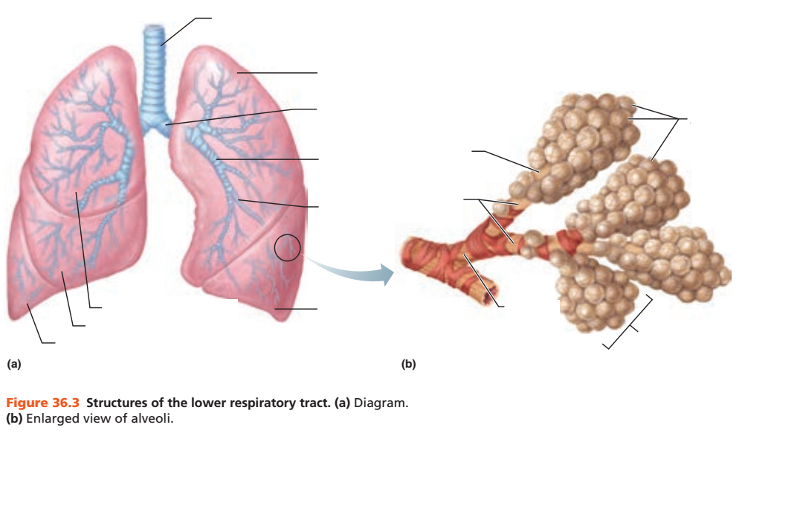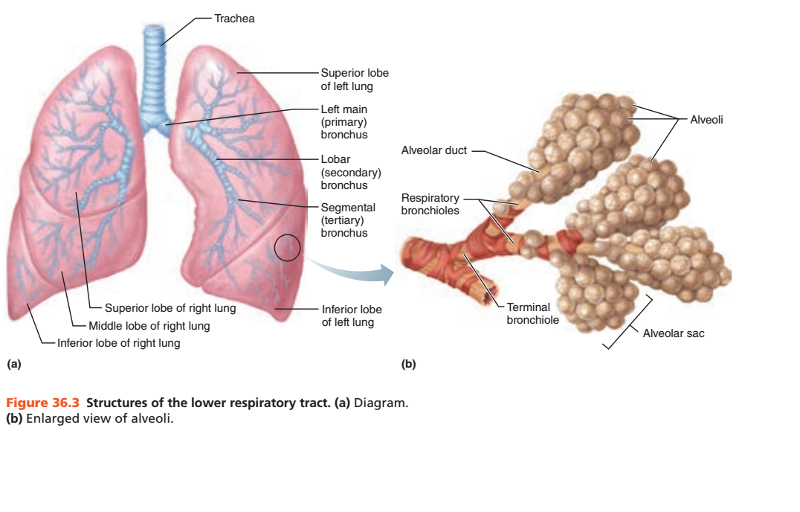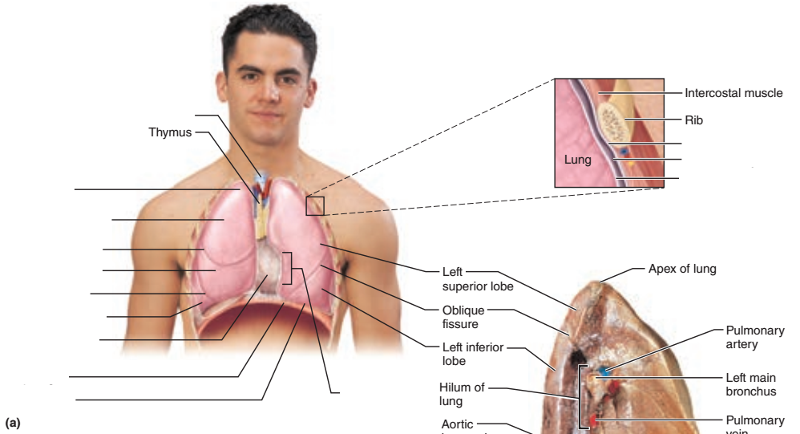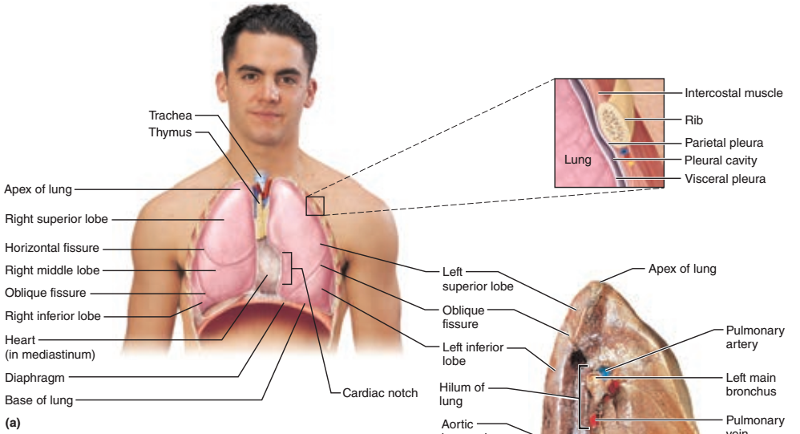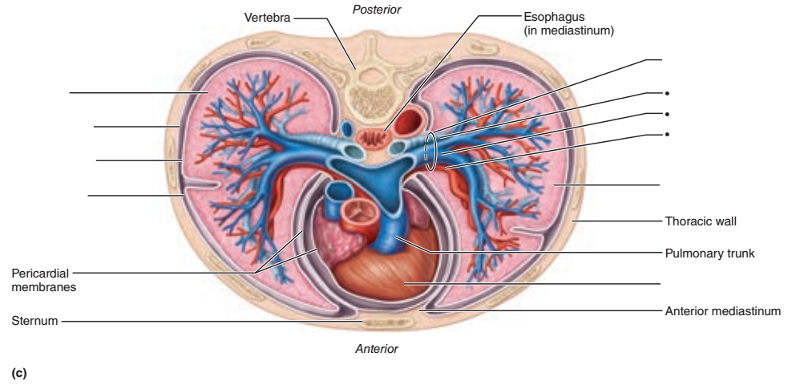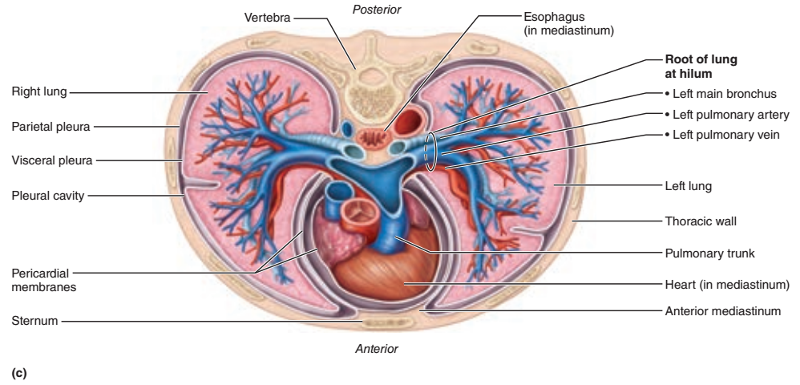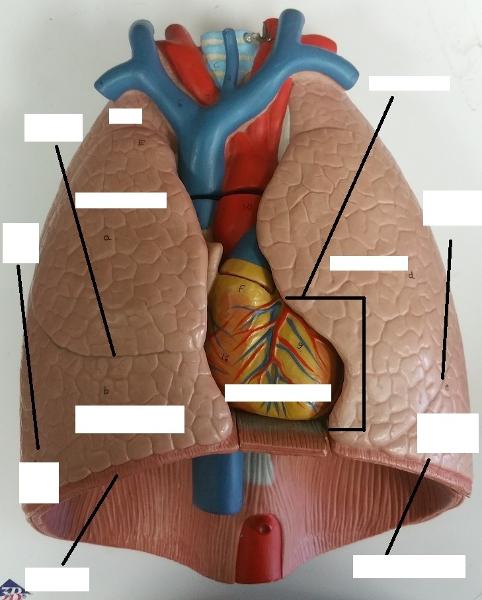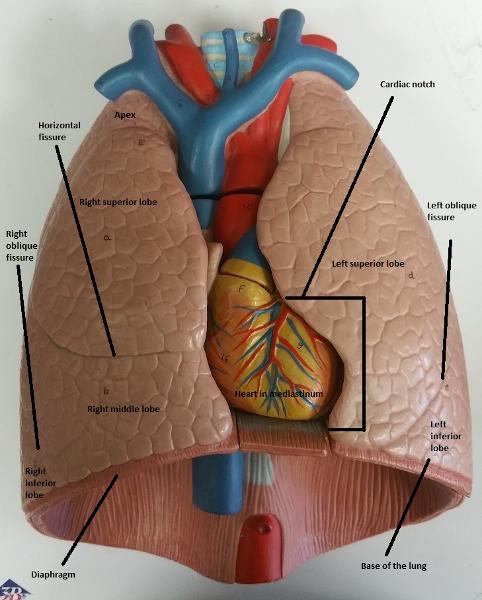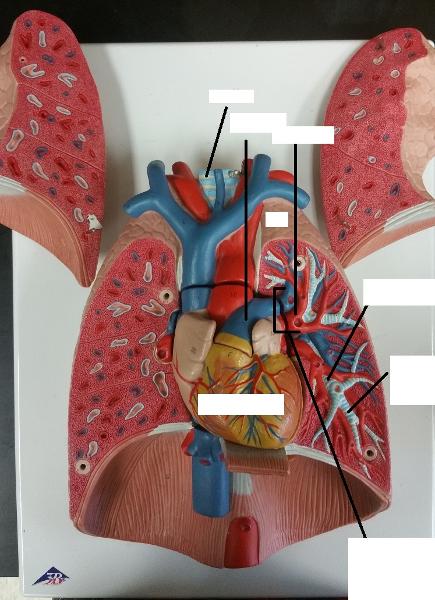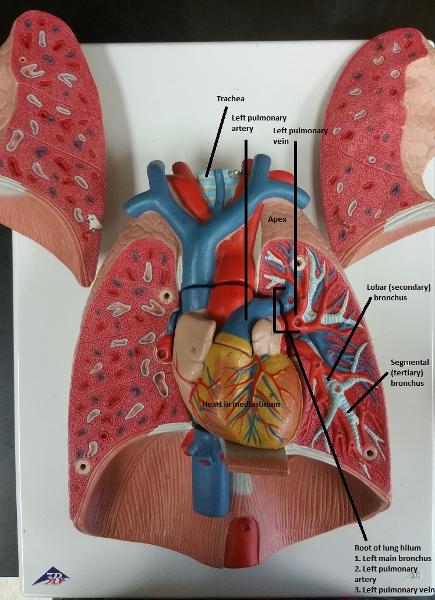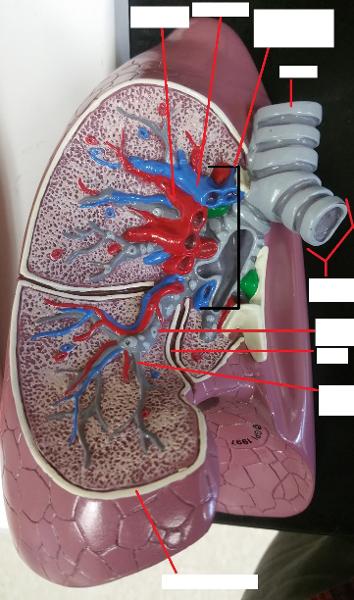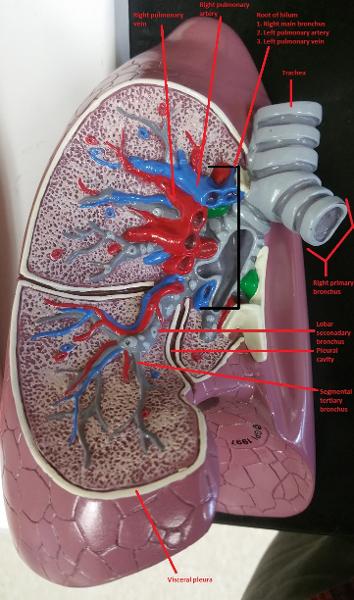The trachea is also commonly known as what?
The windpipe
Air entering the trachea from the larynx travels down to the level of what angle?
Sternal angle
The sternal angle is located where judging from the thoracic vertebrae?
Located between the fourth and fifth thoracic vertebrae
The trachea divides into right and left at which level?
At the level between the fourth and fifth thoracic vertebrae
Between the fourth and fifth thoracic cavity, the trachea divides into what 2 sections?
1. Right primary bronchi
2. Left primary bronchi
The right and left primary bronchis plunge into their respective lungs at which area?
hilum
How is the right primary bronchus different from the left in 3 ways?
1. Wider
2. Shorter
3. More vertical
Why is the right primary bronchus structural differences beneficial?
It is more likely to trap foreign objects
The trachea is lined with what type of cell?
Pseudostratified ciliated columnar epithelium
Mucus is produced by what type of cells?
Goblet cells
What is the purpose of mucus in the trachea?
Traps dust particles, debris, and bacteria
What is the purpose of cilia in the trachea?
Propels mucus that is trapped with dust particles, debris, and bacteria toward the throat where it can be swallowed
The walls of the trachea are reinforced with what type of rings?
C-shaped rings
The C-shaped rings of the trachea walls are made out of what material?
Cartilage
The C-shaped rings of the trachea walls differ posteriorly in which way?
They are incomplete, meaning they don't fully connect
What are the 2 functions of the C-shaped rings?
1. Incomplete parts allow the esophagus to expand anteriorly for a food bolus to pass
2. The solid parts reinforce the trachea walls to keep it open regardless of the pressure changes during breathing
Which muscle allows the trachea to expand?
Trachealis muscle
What are the 8 subsequent divisions of the main bronchi?
1. Lobar
2. Segmental
3. Bronchioles
4. Terminal bronchioles
5. Respiratory bronchioles
6. Alveolar ducts
7. Alveolar sacs
8. Alveoli
Lobar and segmental are also known as what? (Hint: think of the main bronchi being also being called "primary")
Lobar=secondary
Segmental=tertiary
Each bronchiole further divides into what?
Terminal bronchioles
Each terminal bronchiole further divides into what?
Respiratory bronchioles
All of the branches of the main bronchi, except for the smallest branches, have what specific type of reinforcement in their walls?
Hyaline cartilage reinforcement
As the respiratory tubes get smaller and smaller, what happens to the amount of smooth muscle vs the amount of cartilage?
The amount of smooth muscle gradually increases while the amount of cartilage continuously decreases until there is none.
The continuous branching of the respiratory passageways in the lungs if often referred to as what?
Bronchial tree
The respiratory bronchioles further subdivide into what?
Alveolar ducts
The alveolar ducts terminate in what type of structures?
Alveolar sacs
Alveolar sacs then subdivide into what?
Alveoli
Alveoli are composed of what type of cells?
Squamous epithelium
Alveoli are covered with what type of blood vessels?
Capillaries
What 3 walls form the respiratory membrane?
1. Alveolar walls
2. Capillary walls
3. ***And the fused basement membranes of the above two
The respiratory membrane is also called what?
Blood air barrier
The respiratory membrane is the site of what exchange?
Gas exchange
What 3 structures make up the respiratory zone structures?
1. Alveolar sacs
2. Alveolar ducts
3. Respiratory bronchioles
Why are the alveolar sacs, alveolar ducts, and respiratory bronchioles referred to as the respiratory zone structures?
Because gas exchanges occur by simple diffusion across the respiratory membrane
What are conducting zone structures generally?
All other respiratory passageways from the nasal cavity to the terminal bronchioles
How do conducting zone structures get their general name?
Because they simply serve as access or exit routes to and from the gas exchange chambers of the respiratory zone structures; there is no diffusion
Conducting zone structures are also collectively called what?
Anatomical dead space
The paired lungs occupy which cavity except around what structure?
Occupy the entire thoracic cavity except for the mediastinum
The mediastinum house what 3 example organs?
1. Heart
2. Bronchoi
3. Esophagus
Each lung is connected to the mediastinum by what?
A root
A root which connects each lung to the mediastinum contains what 2 attachments?
1. Bronchial attachments
2. Vascular attachments
The structures of the root enter or leave the lung via what medial indentation?
Hilum
All structures distal to the main bronchi are found where?
Within the lung substance
The lung's apex lies deep to what bone?
Clavicle
The lung's base rests on which organ?
Diaphragm
What 3 surfaces make up the costal surface?
1. Anterior lung surface
2. Posterior lung surface
3. Lateral lung surface
Why are the anterior, posterior, and lateral lung surfaces referred collectively to as the costal surface?
They are in close proximity with the ribs
The medial surface of the left lung exhibits what notch?
Cardiac notch
What is the function of the cardiac notch?
Accommodates the heart
Fissures divide the lungs into what?
Lobes
How many lobes are in the left lung?
2
How many lobes are in the right right lung?
3
The lungs are mostly made out of what type of tissue?
Elastic connective tissue
Elastic connective tissue composition provides what functional benefit to the lungs?
Allows them to recoil passively during expiration
Each lung is enclosed in what serous membrane?
Pleura
Describe the pleura structurally. (Hint: type of membrane and type of sac)
Double-layered sac of serous membrane
What is the outer covering layer of the lungs?
Parietal pleura
The parietal pleura is attached to what wall and organ?
Attached to the thoracic wall and the diaphragm.
The inner layer of the lungs is what?
Visceral pleura
The visceral pleura covers what type of tissue?
Lung tissue
The parietal and visceral pleura are separated by what?
Pleural cavity
The pleural cavity is filled with what?
Pleural fluid
The pleural fluid is produced by what?
Pleurae
What is the function of the pleural fluid?
Allows the lungs to glide without friction over the thoracic wall during breathing
